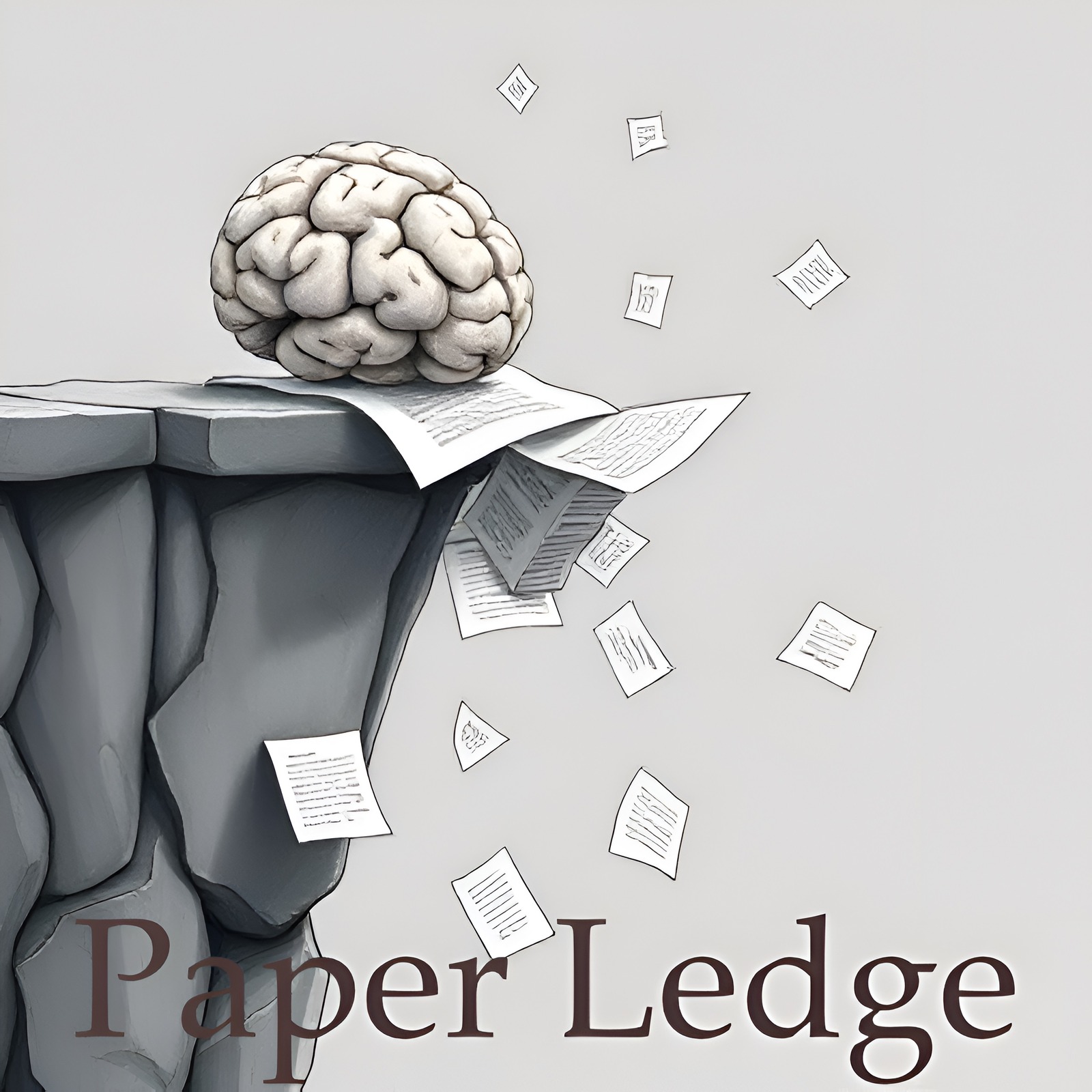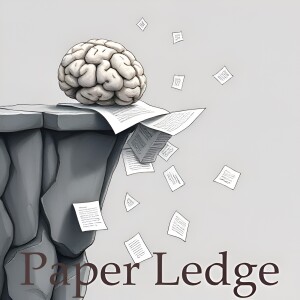PaperLedge

PaperLedge where research meets storytelling is a revolutionary podcast where cutting-edge research meets AI-powered storytelling. Hosted by the Ernis, whose blend of gentle reassurance, cosmic wonder, explanatory clarity, and enthusiastic charm makes complex research accessible to everyone. Each episode, Ernis transforms the latest academic papers into engaging, jargon-free audio experiences that deliver key insights in digestible formats. Whether you’re a researcher seeking interdisciplinary perspectives, a student supplementing your studies, or simply curious about scientific breakthroughs, PaperLedge has something for you.
Episodes
Episodes



Thursday Oct 09, 2025
Computer Vision - Pixel-Perfect Depth with Semantics-Prompted Diffusion Transformers
Thursday Oct 09, 2025
Thursday Oct 09, 2025
Hey PaperLedge crew, Ernis here, ready to dive into another fascinating piece of research! Today, we're tackling a paper about teaching computers to see the world in 3D, just like we do. It's called, let's call it, Pixel-Perfect Depth.
Now, imagine you're trying to create a 3D model of your living room from just a single photo. That's essentially what this research is all about. The tricky part is figuring out how far away everything is – the depth. Traditionally, computers struggle with this, often producing blurry or inaccurate 3D models.
Think of it like trying to paint a photorealistic picture. Current methods are like sketching the basic shapes first, then adding details later. But sometimes, those initial sketches can introduce weird artifacts, like floating lines or smudged edges - they call it flying pixels.
This paper proposes a new approach that's like painting directly onto the canvas, pixel by pixel. The researchers developed a system that generates high-quality 3D models directly from images, skipping the intermediate "sketch" step. This avoids those annoying flying pixels and produces a much cleaner, more realistic result.
So, how does it work? Well, they use something called diffusion models. Imagine it like this: you start with a completely random image, pure noise, like TV static. Then, you gradually "un-noise" it, guided by the original photo, until you have a detailed depth map.
The key innovations here are two things:
Semantics-Prompted Diffusion Transformers (SP-DiT): These are like super-smart filters that understand the meaning of different objects in the image. They use the knowledge of other Vision Foundation Models (think of them as pre-trained expert image recognizers) to guide the "un-noising" process, making sure that the resulting 3D model is both visually accurate and semantically consistent. It's like having an art critic whispering suggestions in your ear as you paint, ensuring everything makes sense.
Cascade DiT Design: This is all about efficiency. Instead of processing the entire image at once, they start with a low-resolution version and gradually increase the detail. It's like zooming in on a map: you start with the big picture and then focus on specific areas to see the finer details. This significantly speeds up the process and improves accuracy.
The result? The paper claims their model significantly outperforms existing methods in creating accurate 3D models. They tested it on five different datasets and achieved the best results across the board, especially when it comes to the sharpness and detail of the edges in the 3D model.
Why does this matter?
For game developers, this could mean creating more realistic and immersive environments.
For robotics engineers, it could enable robots to better understand their surroundings and navigate more effectively.
For architects, it could provide a faster and more accurate way to create 3D models of buildings from photographs.
This research is a big step forward in teaching computers to see the world as we do. By combining the power of diffusion models with semantic understanding and efficient processing techniques, they've created a system that can generate high-quality 3D models from single images with impressive accuracy.
Questions that come to mind:
How well does this system handle images with complex lighting or unusual perspectives?
Could this technology be used to create 3D models of people from photographs, and what are the ethical implications of that?
I'm curious to hear your thoughts on this, PaperLedge crew. Could you see this technology being integrated into your workflow or personal projects?Credit to Paper authors: Gangwei Xu, Haotong Lin, Hongcheng Luo, Xianqi Wang, Jingfeng Yao, Lianghui Zhu, Yuechuan Pu, Cheng Chi, Haiyang Sun, Bing Wang, Guang Chen, Hangjun Ye, Sida Peng, Xin Yang



Wednesday Oct 08, 2025
Machine Learning - Thermodynamic Performance Limits for Score-Based Diffusion Models
Wednesday Oct 08, 2025
Wednesday Oct 08, 2025
Hey PaperLedge listeners, Ernis here, ready to dive into some fascinating research! Today, we're unpacking a paper that connects the seemingly disparate worlds of AI image generation and… thermodynamics. Yes, you heard right, the same stuff you might remember from high school physics!
So, imagine you're baking a cake. You start with a bunch of separate ingredients – flour, sugar, eggs – all nicely organized. Now, think of a score-based diffusion model as a reverse-baking machine. Instead of combining ingredients, it starts with a completely randomized, "noisy" image – like a blurry mess of pixels – and slowly "un-bakes" it, step-by-step, until you get a clear, coherent image. It's like meticulously separating all those cake ingredients back into their original containers, but with images!
This paper's big idea is linking how well these image-generating models work to something called entropy. Entropy, in simple terms, is a measure of disorder. Think of your messy desk versus a perfectly organized one. The messy desk has higher entropy.
What the researchers did was develop a kind of "speed limit" for these models, based on how quickly the "disorder" changes during the image generation process. They found a mathematical relationship between how well the model can recreate images and the rate at which entropy is changing.
Think of it like this: imagine trying to unscramble an egg. The faster you try to put it back together perfectly, the more energy (and probably frustration!) it takes. Similarly, the faster an AI tries to "un-bake" an image, the harder it works to reduce the disorder, and that has a fundamental limit.
But why should we care about entropy and image generation?
For AI Researchers: This research gives us a new way to understand and evaluate these image-generating models. It's like having a new tool to diagnose why a model might be underperforming.
For Physicists: It provides a concrete example of how principles from thermodynamics – the science of heat and energy – can be applied to information processing.
For Everyone Else: It highlights the deep connections between seemingly unrelated fields and suggests that there are fundamental physical limits to what AI can achieve.
The paper also touches upon some really cool concepts, like Maxwell's Demon, a thought experiment about a tiny creature that can seemingly violate the laws of thermodynamics. The researchers suggest that these diffusion models, in a way, act like Maxwell's Demon, sorting information and reducing entropy.
They also hint at the possibility of building new types of computers based on thermodynamic principles, potentially leading to more energy-efficient AI.
"By building a bridge to entropy rates...we provide new insights into the thermodynamic operation of these models, drawing parallels to Maxwell's demon and implications for thermodynamic computing hardware."
The researchers even tested their ideas on a simple, artificial dataset to see if their "speed limit" held up. And guess what? It did! This gives us confidence that their theoretical framework is on the right track.
So, what does all this mean? Well, it suggests that the performance of AI image generation is fundamentally linked to the laws of physics. There's a limit to how fast and efficiently we can create these images, and that limit is dictated by entropy.
This opens up some really interesting questions:
Could we design better AI models by explicitly taking into account these thermodynamic principles?
Could we build entirely new types of computers that are optimized for entropy management?
What are the ultimate physical limits of AI, and how far can we push them?
Food for thought, right? I'm curious to hear your thoughts on this. Let me know what you think in the comments!Credit to Paper authors: Nathan X. Kodama, Michael Hinczewski



Wednesday Oct 08, 2025
Wednesday Oct 08, 2025
Hey PaperLedge crew, Ernis here, ready to dive into some seriously cool research! Today, we're tackling a paper that's all about making those massive language models, like the ones powering your favorite chatbots, run faster and cheaper. Think of it as giving these digital brains a super-efficient memory upgrade.
The core problem? These language models, especially when dealing with long conversations or complicated tasks, need a HUGE memory called the "Key-Value cache" or KV cache to remember everything. It's like a digital notepad where they scribble down important details. But this notepad takes up a ton of space, slowing things down and costing a lot of money.
Now, clever folks have been trying to shrink this notepad using a technique called "vector quantization" or VQ. Imagine you have a giant box of crayons, but you only really use a handful of colors. VQ is like saying, "Instead of keeping all those crayons, let's just keep the most important ones and use those to represent everything else." This saves space, but sometimes, especially when you try to use really few crayons (aka ultra-low bit-widths), things get messy.
Think of it like trying to paint a masterpiece with only two colors. You're going to lose a lot of detail!
The paper we're looking at today introduces a new method called VecInfer. What's unique about it? It's designed to handle those messy situations when you're trying to compress the KV cache aggressively.
Here's the magic: VecInfer uses some clever mathematical tricks – specifically, "smooth and Hadamard transformations" – to basically even out the data in the KV cache. Imagine you have a bunch of hills and valleys in your data. These transformations are like using a bulldozer to flatten the landscape. This makes it much easier for the "codebook" (our set of essential crayons) to represent everything accurately, even when you're using very few "crayons."
Think of it like this: Instead of trying to represent a spiky mountain range with just a few colors, you're representing a smooth, rolling landscape. Much easier!
But wait, there's more! The researchers also designed a special "CUDA kernel" (a fancy term for a piece of optimized code) that combines the process of accessing the compressed data and turning it back into a usable format. This minimizes the time spent shuffling data around, leading to even faster performance.
So, what did they find? The results are pretty impressive! VecInfer consistently outperformed other methods, especially when dealing with long-context understanding (like reading a really long book) and mathematical reasoning (like solving complex equations). In fact, with only 2-bit quantization (that's like using only two "crayons"), VecInfer achieved performance comparable to using the full range of colors! They saw up to a 2.7x speedup in large-batch computations and an 8.3x reduction in end-to-end latency on a popular language model called Llama-3.1-8B with a massive 196k sequence length.
Why does this matter?
For developers: This means you can run bigger, more complex language models on less powerful hardware, saving time and money.
For users: This means faster, more responsive chatbots and AI assistants.
For researchers: This opens the door to exploring even larger and more sophisticated language models that were previously impractical due to memory constraints.
This research is exciting because it tackles a critical bottleneck in the development and deployment of large language models. By making these models more efficient, VecInfer could help bring the power of AI to more people and applications.
Here are a couple of things that really got me thinking:
Could VecInfer be applied to other types of AI models, not just language models?
What are the limitations of using such aggressive quantization? Are there certain tasks where it might not be suitable?
That's all for today's deep dive! Let me know what you think in the comments. Until next time, keep learning, keep exploring, and keep pushing the boundaries of what's possible!Credit to Paper authors: Dingyu Yao, Chenxu Yang, Zhengyang Tong, Zheng Lin, Wei Liu, Jian Luan, Weiping Wang



Wednesday Oct 08, 2025
Machine Learning - On Powerful Ways to Generate Autoregression, Diffusion, and Beyond
Wednesday Oct 08, 2025
Wednesday Oct 08, 2025
Hey PaperLedge learning crew, Ernis here, ready to dive into another fascinating piece of research! Today, we're tackling a paper that looks under the hood of how AI generates things – think text, code, even scientific models. It's not about the specific AI model being used, but about the process of generation itself.
Think of it like this: imagine you're building a Lego castle. Some methods are like adding one brick at a time, always building onto the existing structure – that's similar to what's called auto-regressive next-token prediction. It's like your phone predicting the next word you're going to type. Other methods are like starting with a whole bunch of random bricks and then slowly shaping them into the castle you want - that's similar to masked diffusion. It's a bit more chaotic but can lead to interesting results.
Now, this paper takes a step back and asks: what are the inherent limits and strengths of these different approaches? Can we actually measure how hard it is for an AI to generate something using these methods? And how easily can it learn to do it well? The researchers look at things like computational hardness (how much processing power it needs) and learnability (how much data it needs to become good at the task).
But here's the really cool part. The paper argues that current methods, like just predicting the next word or slowly shaping a chaotic starting point, might not be enough for the really tough challenges ahead. What if, instead of just adding bricks, you could remove bricks, rearrange sections, or even change the overall size of your Lego creation mid-build? That's what the researchers are proposing for AI: allowing it to rewrite and edit what it's generating in a flexible way.
"Allowing generation to proceed beyond autoregression and current masked diffusion, with capabilities to rewrite and length-variable edit, can bring significant theoretical and empirical advantages..."
Why is this important? Well, imagine you're trying to write complex code, or design a new molecule. Sometimes you need to go back and change things fundamentally. This paper suggests that giving AI the power to do that could unlock its potential to tackle these kinds of incredibly hard problems. It’s about equipping AI with the tools to not just create, but to evolve its creations.
So, why should you care about this research?
For aspiring AI developers: This paper highlights the potential of new generation techniques and could inspire novel architectures.
For anyone curious about the future of AI: It offers a glimpse into the next generation of AI models that can handle more complex and creative tasks.
For those in fields like coding or science: It suggests a future where AI can assist in these domains more effectively by being able to edit and refine its outputs.
This research has some pretty big implications, right? It could change how AI approaches complex problem-solving, opening up new possibilities in fields from code generation to scientific discovery.
Here are a couple of questions that popped into my head:
If we give AI this much flexibility to rewrite and edit, how do we ensure it stays aligned with our goals and values? Could it introduce unintended errors or biases?
What kind of new AI architectures would be needed to effectively implement these rewrite and edit capabilities? Is it just a matter of software, or do we need fundamentally different hardware too?
Let me know what you think! Hit me up on the PaperLedge socials and let's keep the conversation going!Credit to Paper authors: Chenxiao Yang, Cai Zhou, David Wipf, Zhiyuan Li



Wednesday Oct 08, 2025
Computation and Language - Latent Speech-Text Transformer
Wednesday Oct 08, 2025
Wednesday Oct 08, 2025
Hey PaperLedge crew, Ernis here, ready to dive into some seriously cool research! Today, we're tackling a paper that's all about making AI models that understand and generate speech way more efficiently. Think of it like this: imagine teaching a computer to translate English to Spanish, but instead of words, it's translating spoken words into... well, other spoken words, or even written text!
Now, these models, called "auto-regressive speech-text models," are usually trained on tons and tons of data - like, massive amounts of text and speech recordings. The problem is that speech data is usually much, much longer than text data. Imagine reading a sentence versus hearing someone say the same sentence, complete with pauses, "umms," and all the natural stuff that makes speech longer. This difference in length creates a huge imbalance during training. It's like trying to balance a feather and a bowling ball – the bowling ball (speech) takes up all the computational resources, slowing everything down and making it harder to accurately link the speech to the text. It also makes the model more expensive to train.
The researchers behind this paper have come up with a clever solution they call the "Latent Speech-Text Transformer," or LST for short. Think of LST as a smart organizer for speech data. Instead of treating every single tiny sound unit individually, it groups them together into bigger, more meaningful "patches."
It's like taking a bunch of LEGO bricks and combining them into larger, pre-built sections.
These "speech patches" can represent things like common sounds, pauses, or even short words.
This way, the model doesn't have to process every single tiny sound individually, making it faster and more efficient.
By creating these "speech patches", the LST model can more easily match up speech with corresponding text, meaning better alignment between the two, and better performance overall.
So, why does this matter? Well, for a few key reasons:
For AI developers: This technique could lead to much more efficient and powerful speech-to-speech and speech-to-text models, opening up new possibilities for voice assistants, translation tools, and more.
For businesses: Imagine faster, more accurate transcription services, or AI-powered customer service agents that can truly understand and respond to customer needs.
For everyone: More efficient AI means less energy consumption, which is a win for the environment!
The researchers tested their LST model on a few different benchmarks, and the results were impressive. They found that LST outperformed the standard approaches, especially in situations where they controlled for both data amount and computing power. In one experiment, on a story completion task called HellaSwag, the LST model showed a significant performance boost in understanding speech.
"On HellaSwag story completion, LST achieves 6.5% absolute gain in speech accuracy under compute-controlled training and 5.3% under data-controlled training, while also improving text performance."
This suggests that LST is not only more efficient but also better at understanding the meaning behind speech. And the best part? They're releasing their models, code, and evaluation data, so other researchers can build upon their work!
This paper really got me thinking about a couple of things. First, how can we ensure that these AI models are trained on diverse datasets that accurately represent different accents, dialects, and speaking styles? If the model is only trained on one particular type of speech, it's unlikely to work as well on other people. Secondly, as these models become more sophisticated, how do we ensure that they are used ethically and responsibly? What are your thoughts, crew?Credit to Paper authors: Yen-Ju Lu, Yashesh Gaur, Wei Zhou, Benjamin Muller, Jesus Villalba, Najim Dehak, Luke Zettlemoyer, Gargi Ghosh, Mike Lewis, Srinivasan Iyer, Duc Le



Wednesday Oct 08, 2025
Wednesday Oct 08, 2025
Hey PaperLedge crew, Ernis here, ready to dive into something truly out of this world! We're talking about stars, data, and some seriously smart algorithms.
So, imagine you're watching a star. Not just with your eyes, but with super-powered telescopes that track its brightness over time. This creates what astronomers call a "light curve" - a graph showing how the star's brightness changes. These light curves can tell us all sorts of cool things about the star, like whether it's pulsating, exploding, or has planets orbiting it.
Now, astronomers have been using special computer programs, designed specifically for this task, to analyze these light curves. But what if we could use general-purpose AI – the kind trained on all sorts of data except for astronomical data – to do an even better job?
That's where this paper comes in! Researchers have created something called StarEmbed. Think of it as a standardized testing ground for AI models, specifically when applied to these stellar light curves. It's a benchmark to see how well these general AI models can understand and classify different types of stars based on their light curves.
Why is this important? Well, imagine trying to teach a dog a new trick. You could spend hours training it specifically for that one trick. Or, you could focus on general obedience and intelligence, which would allow the dog to learn many tricks more easily. Similarly, these researchers are asking: can AI models trained on everything learn about stars just as well or even better than AI models trained only on star data?
The researchers took about 40,000 labeled light curves (meaning experts had already identified what kind of star each one was) from the Zwicky Transient Facility. These light curves represent seven different types of stars, offering a rich dataset for testing.
They then pitted several general-purpose AI models – specifically something called Time Series Foundation Models (TSFMs) – against a specialized AI model called Astromer, which was designed just for astronomical data, and against traditional methods used by astronomers (called "handcrafted feature extraction").
Here's the really cool part: the general-purpose AI models, especially those called Chronos and Chronos-Bolt, which were trained on entirely different kinds of data, actually performed surprisingly well! In some cases, they even outperformed the models specifically designed for astronomical data and traditional methods. They were particularly good at spotting unusual or "out-of-distribution" stars – the outliers that astronomers might otherwise miss.
The models showed good performance on three main tasks:
Unsupervised clustering: Grouping stars based on similarities in their light curves, without being told what the groups should be.
Supervised classification: Correctly identifying the type of star based on its light curve, given examples of each type.
Out-of-distribution source detection: Finding stars that don't fit into any of the known categories – potentially uncovering new and exciting astronomical phenomena.
So, what does all this mean? It suggests that we might be able to leverage these powerful, general-purpose AI models to analyze the massive amounts of data coming from new telescopes. Instead of building specific AI models for each task, we can use these foundation models as a starting point, saving time and resources.
"With the first benchmark of TSFMs on astronomical time series data, we test the limits of their generalization and motivate a paradigm shift in time-domain astronomy..."
Think of it like this: instead of having a separate app for every single function on your phone, you have a powerful operating system that can run almost anything. That's the potential of these Time Series Foundation Models for astronomy.
This research has big implications for:
Astronomers: They can use these models to analyze vast datasets more efficiently and potentially discover new phenomena.
AI researchers: It shows the power of general-purpose AI and provides a challenging new domain to test their models.
Citizen scientists: As these tools become more accessible, it could empower more people to participate in astronomical discoveries.
Here are a few things that popped into my head:
If these general AI models can perform so well without being trained on astronomical data, what could they achieve with some fine-tuning using star data?
How can we make these AI models more accessible to astronomers who may not be experts in machine learning?
Could this approach be applied to other scientific fields that deal with time series data, such as climate science or finance?
That's it for this week's deep dive! Let me know what you think of using general AI to study the stars. Until next time, keep looking up!Credit to Paper authors: Weijian Li, Hong-Yu Chen, Qinjie Lin, Nabeel Rehemtulla, Ved G. Shah, Dennis Wu, Adam A. Miller, Han Liu



Wednesday Oct 08, 2025
Wednesday Oct 08, 2025
Hey PaperLedge crew, Ernis here! Get ready to dive into some seriously cool research that's all about making AI assistants way smarter. We're talking about giving them the power to not just answer simple questions, but to tackle complex, multi-step problems that require them to use tools like search engines.
So, imagine you're trying to plan a surprise birthday party. You need to find a venue, order a cake, send out invitations, and maybe even hire a DJ. That's a multi-step problem, right? Now, think about teaching an AI to do the same thing, but instead of party planning, it's answering a really complicated question. To do this effectively, these AI agents use search engines a lot, hopping across the web to find the info they need. They learn to do this using something called reinforcement learning – basically, rewarding the AI when it gets closer to the right answer.
Now, here's where things get tricky. Imagine that for each search the bot does, it takes a different path. Sometimes it needs five searches, other times only two. Sometimes the first search is super helpful, other times, not so much. This creates a bunch of different “strata” or levels of success and pathways in the AI's learning process. The problem is that using a one-size-fits-all approach to reward these different paths can lead to what the researchers call cross-stratum bias. Think of it like comparing apples to oranges – you're not giving the AI a fair assessment of its performance if you're lumping all these different search paths together!
"Standard policy gradient methods, which use a single global baseline, suffer from what we identify and formalize as cross-stratum bias-an 'apples-to-oranges' comparison of heterogeneous trajectories."
So, what's the solution? These researchers came up with something called Stratified GRPO. The key ingredient here is something called Stratified Advantage Normalization (SAN). Think of it like sorting those apples and oranges into separate baskets before you start comparing them. SAN looks at the AI's search paths and groups them into similar "strata" based on how many searches it took, how useful those searches were, and so on. Then, it figures out how well the AI did within each group. This way, you're only comparing apples to apples, and oranges to oranges.
This approach makes the learning process much more fair and accurate, giving the AI a clearer signal of what it's doing right and wrong. The researchers even proved mathematically that SAN gets rid of this cross-stratum bias, leading to a more stable and reliable learning process. They even added a little tweak to make sure it works well in real-world situations where you don't have infinite examples.
The results were impressive! They tested Stratified GRPO on different question-answering tasks and found that it consistently outperformed the standard approach, sometimes by a pretty significant margin. This means the AI agents trained with Stratified GRPO were not only getting more questions right, but they were also developing more efficient and effective search strategies.
So, why does this matter? Well, for the average listener, this research means that AI assistants are getting closer to being able to handle complex tasks that require real problem-solving skills. For developers and researchers, it provides a powerful new tool for training AI agents that can effectively use external tools like search engines. It lays the groundwork for more robust and reliable AI systems that can tackle a wider range of challenges.
Here are a couple of questions that spring to mind:
If we can successfully stratify based on search behavior, could we apply similar techniques to other areas of AI learning where there's inherent heterogeneity in the data or task?
Are there other ways to define these "strata" beyond just the number and outcomes of search calls? Could we incorporate things like the type of question being asked or the AI's confidence level?
That's all for this episode, PaperLedge crew. Until next time, keep learning!Credit to Paper authors: Mingkang Zhu, Xi Chen, Bei Yu, Hengshuang Zhao, Jiaya Jia



Wednesday Oct 08, 2025
Wednesday Oct 08, 2025
Hey PaperLedge crew, Ernis here! Get ready to dive into some seriously smart research that's all about making AI better at understanding and working with tables of data. Think spreadsheets, databases – all that good stuff!
So, we've talked before about Large Language Models (LLMs), those powerful AIs that can generate text, translate languages, and even write different kinds of creative content. But what happens when you throw a table of numbers or facts at them? Turns out, even the smartest LLMs can struggle. It’s like asking a brilliant novelist to do your taxes – they might be able to figure it out, but it’s not their strong suit.
That's where this paper comes in. Researchers are exploring something called Process Reward Models (PRMs). Imagine you're teaching a dog a new trick. Instead of just giving a treat when they finally do the whole trick right, you give smaller treats along the way for each step they get correct. PRMs do something similar for AI. They reward the AI for each correct step it takes while solving a problem, leading to better reasoning.
Now, existing PRMs are pretty good at helping AI with text-based tasks. But this paper points out a problem: they aren't so great when it comes to dealing with tables. Think about it: tables require specific operations like finding the right section (sub-table retrieval) and understanding the table's structure (schema interaction). It's like trying to use a hammer to screw in a screw – the wrong tool for the job!
That's why the researchers created TaTToo, a new PRM specifically designed for tabular reasoning. Think of it as giving your AI a special pair of glasses that helps it see and understand tables clearly.
Here's how TaTToo works its magic:
Step 1: Table-Focused Reasoning. TaTToo is trained to explicitly consider each step involved in solving a problem using a table. It breaks down the problem into smaller, more manageable chunks.
Step 2: Tool-Based Verification. TaTToo uses tools to double-check its work. Imagine having a calculator to verify your math or a search engine to confirm a fact. This helps ensure accuracy.
To train TaTToo, the researchers created a massive dataset of over 60,000 examples. That's like giving your AI a huge textbook full of solved table problems!
The training process itself has two stages:
Cold-Start SFT: First, they use supervised fine-tuning to teach TaTToo the basics of using tools for table-based tasks. It’s like showing the AI how to use the calculator.
RL with Tool-Grounded Reward Shaping: Then, they use reinforcement learning to fine-tune TaTToo based on the rewards it gets for using the tools correctly. This is like letting the AI practice and learn from its mistakes, with the tool-based verification guiding it along the way.
So, what were the results? Drumroll please… TaTToo significantly improved the AI's ability to reason with tables. In fact, it boosted performance by a whopping 30.9% across various challenging tasks, including numerical reasoning, fact-checking, and data analysis!
“TaTToo improves downstream policy LRMs by 30.9% at inference... and demonstrates strong generalizability across diverse TTS strategies.”
Even better, TaTToo, with only 8 billion parameters, outperformed other PRMs that were much larger (72 billion parameters!). It’s like a smaller, smarter student outperforming a larger, less focused one.
Why does this matter?
For businesses: Imagine AI assistants that can accurately analyze sales data, identify trends, and make informed recommendations.
For researchers: This opens up new possibilities for AI to assist with scientific data analysis, medical diagnosis, and other complex tasks.
For everyday users: Think about AI tools that can help you manage your finances, compare prices, or even plan your next vacation based on table data.
This research is a big step forward in making AI more capable and reliable when it comes to working with tabular data. It shows that by focusing on the specific challenges of table reasoning and providing targeted rewards, we can significantly improve AI performance.
Here are a couple of things I'm pondering after reading this paper:
How can we make TaTToo even more efficient and scalable so it can handle even larger and more complex tables?
Could we adapt the principles of TaTToo to improve AI's ability to reason with other types of structured data, like graphs or knowledge bases?
That's all for today's dive into PaperLedge. I hope you found this breakdown of TaTToo helpful! Until next time, keep learning and keep questioning!Credit to Paper authors: Jiaru Zou, Soumya Roy, Vinay Kumar Verma, Ziyi Wang, David Wipf, Pan Lu, Sumit Negi, James Zou, Jingrui He







